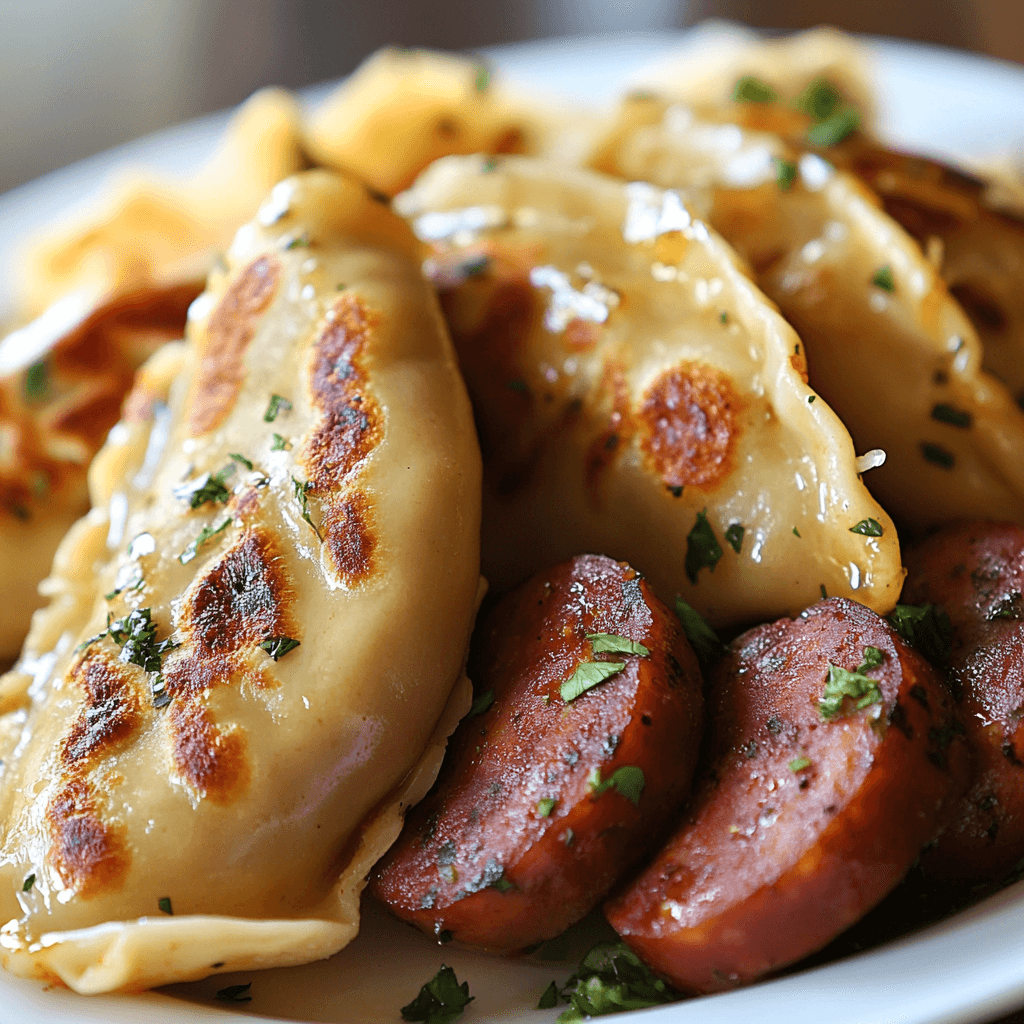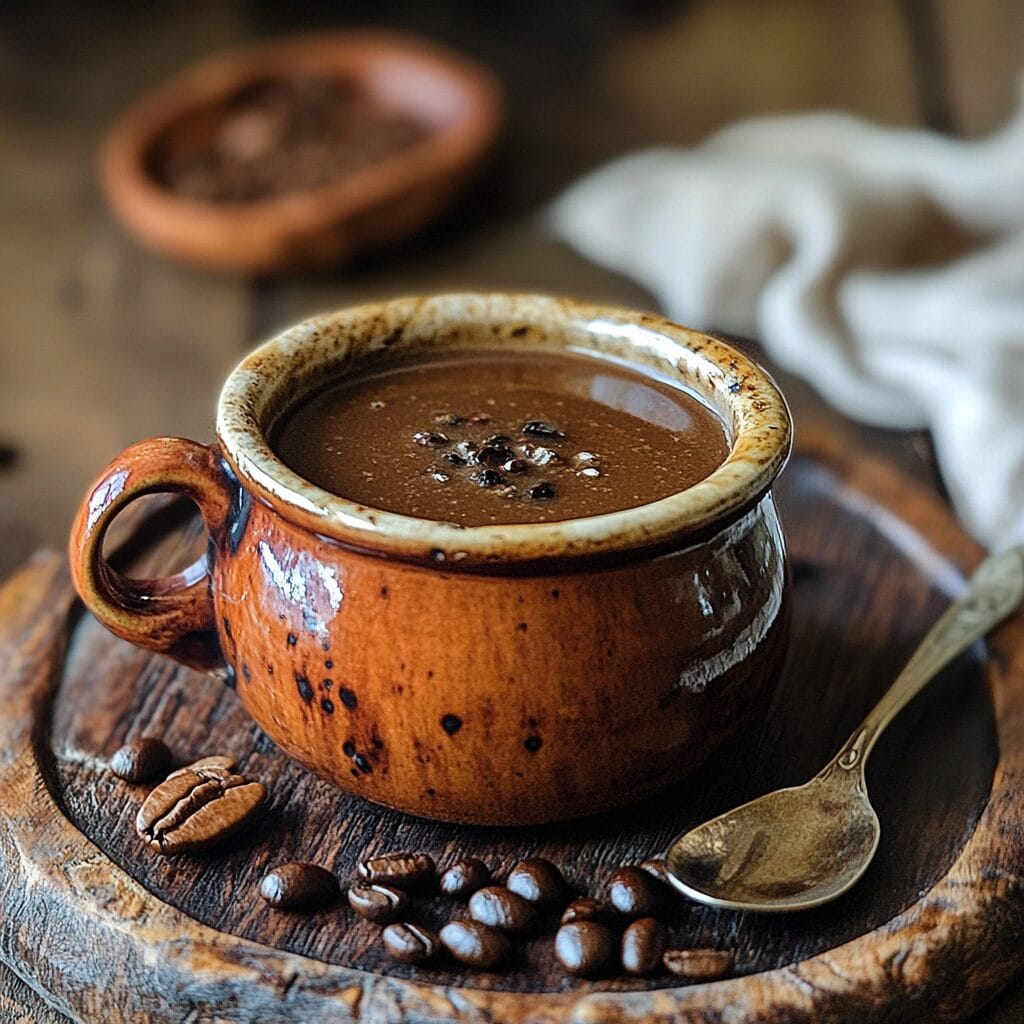Pierogies and kielbasa could be your new go-to comfort combo if you enjoy hearty, soul-warming meals. This article will take you deep into the world of this Eastern European classic from where it all started to how to cook it, serve it, and even mix things up with modern twists. We’ll explore easy cooking methods, nutritional tips, and smart ways to store leftovers. Whether you’re a curious cook or just craving something new for dinner, you’re in for a treat.
“The first time I tried pierogies and kielbasa was during a snowy winter in Kraków. The pierogies were soft and cheesy, the kielbasa smoky and crisp it was like a warm hug on a cold day. I’ve been hooked ever since. This dish is more than food. It’s comfort, tradition, and a celebration all in one.”
– Chef Daria Nowak, Eastern European Culinary Specialist
Let’s kick things off with the basics and explore what makes pierogies and kielbasa such a timeless pair.
What Are Pierogies and Kielbasa?
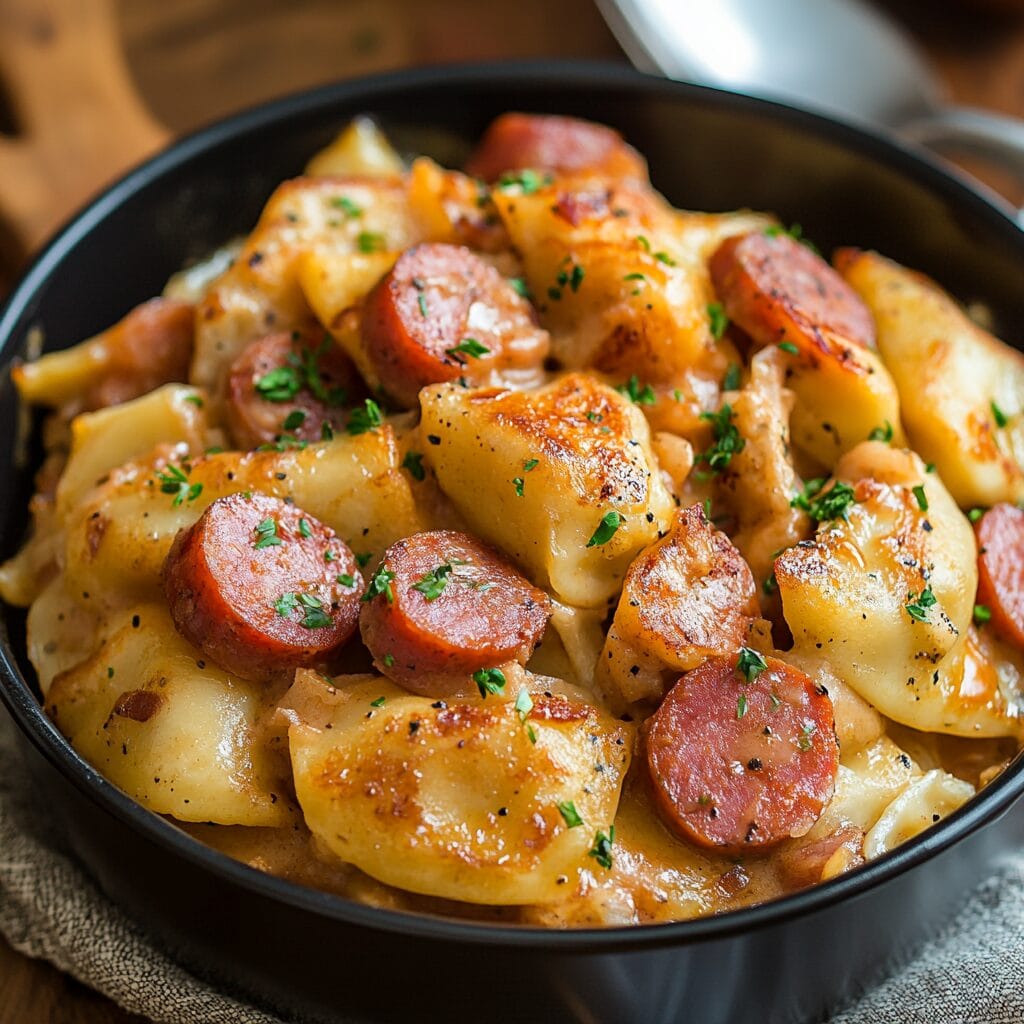
Defining Pierogies: Traditional Fillings and Varieties
Pierogies (also spelled “perogies” or “pirogi”) are pillowy dumplings that come from Central and Eastern Europe. They’re made with soft dough, folded over and sealed around a filling. Then they’re boiled, pan-fried, or even baked.
The fillings? Oh, they’re as varied as the people who make them.
| Classic Pierogi Fillings | Description |
|---|---|
| Potato & Cheese | Creamy mashed potatoes mixed with cheddar |
| Sauerkraut & Mushroom | Tangy cabbage with earthy mushrooms |
| Ground Meat | Savory beef or pork |
| Sweet Cheese | Farmer’s cheese with a touch of sugar |
| Fruit (blueberry, plum) | Often served as dessert |
Kids love the cheesy ones, while adults often lean toward the tangy sauerkraut or hearty meat fillings. You can find frozen pierogies in stores, but homemade versions taste extra special.
“My grandmother made potato and cheese pierogies every Friday. They were soft, buttery, and perfect with just a dollop of sour cream.”
Understanding Kielbasa: Types and Characteristics
Now let’s talk kielbasa. That’s the Polish word for sausage, and it’s not just any sausage it’s a superstar in Polish cuisine. It’s smoky, garlicky, and oh-so-juicy.
There are different kinds of kielbasa, each with its own flavor and texture. Here’s a quick look:
| Type of Kielbasa | Main Features |
|---|---|
| Kielbasa Polska (Smoked) | Most popular, smoky flavor, fully cooked |
| Kielbasa Wiejska | Made with pork and veal, usually U-shaped |
| Fresh Kielbasa (White) | Uncooked, needs to be boiled or grilled |
| Kabanosy | Thin, dry sausage, often eaten as a snack |
Kielbasa is usually made with pork, though you’ll also find beef or turkey versions at the store. Its bold flavor pairs beautifully with the gentle taste of pierogies.
So, when you put them together? Magic.
The Origins of Pierogies and Kielbasa
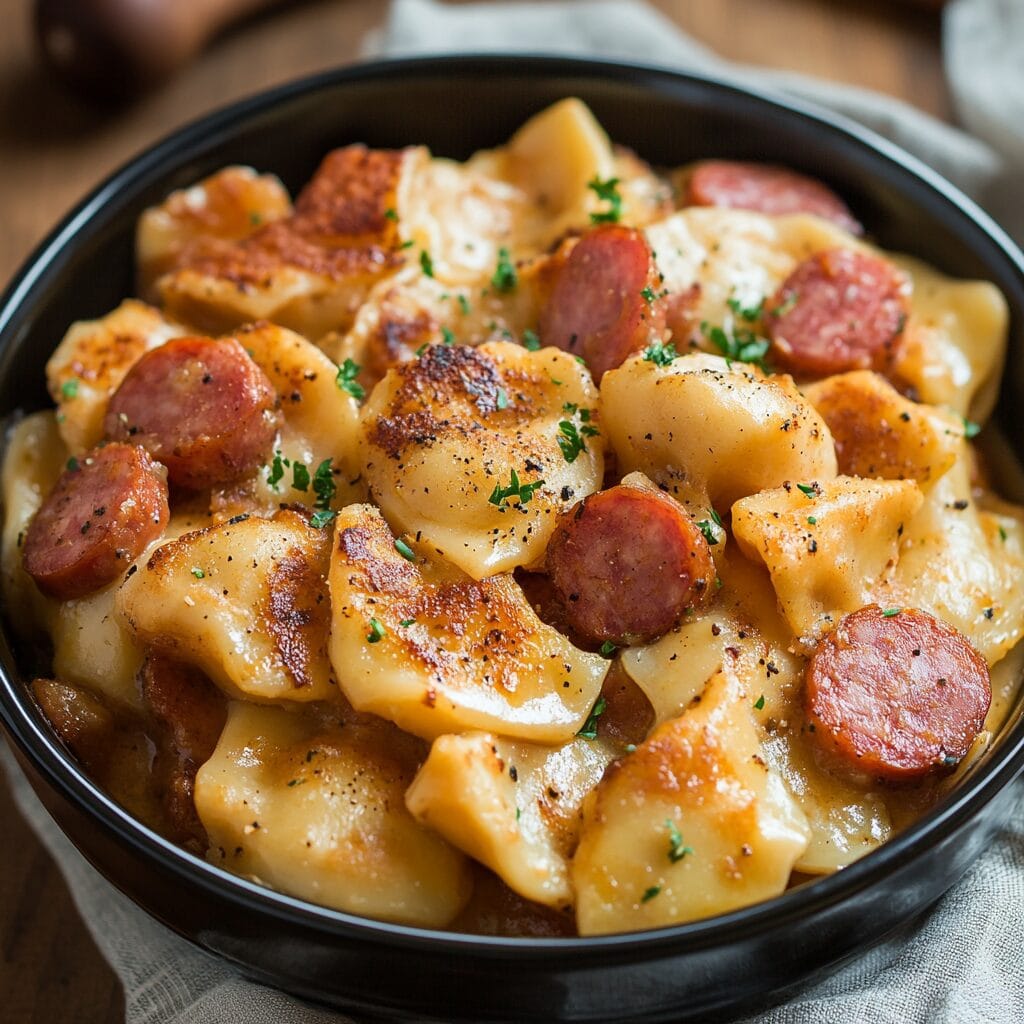
The History of Pierogies in Eastern Europe
Pierogies, those delightful dumplings, have a history as rich as their fillings. While their exact beginnings are a bit hazy, many believe they traveled from Asia to Europe during the Middle Ages. Some say that Saint Hyacinth of Poland introduced them to the country after a trip to Kyiv in the 13th century. Legend has it that he shared these tasty morsels with the poor in Kraków after a Tatar invasion, earning him the nickname “Saint Hyacinth with his pierogi.”
The first known recipe for pierogies appeared in a Polish cookbook called “Compendium Ferculorum” in 1682. Over time, pierogies became a staple in Polish cuisine, with different regions creating their own unique versions. Traditionally considered peasant food, pierogies eventually gained popularity and spread throughout all social classes, including the nobility.
“Pierogies are more than just food; they’re a symbol of Polish heritage and resilience.”
The Evolution of Kielbasa: From Poland to the World
Kielbasa, the Polish word for sausage, has deep roots in Poland’s culinary history. The term “kielbasa” simply means “sausage” in Polish and encompasses a variety of types.
By the 18th and 19th centuries, kielbasa had become a beloved staple in Polish households. Its popularity grew, and with Polish immigrants, it found its way to other countries, introducing the world to this flavorful sausage.
“Kielbasa’s smoky aroma brings back memories of family gatherings and festive celebrations.”
Why Pierogies and Kielbasa Complement Each Other
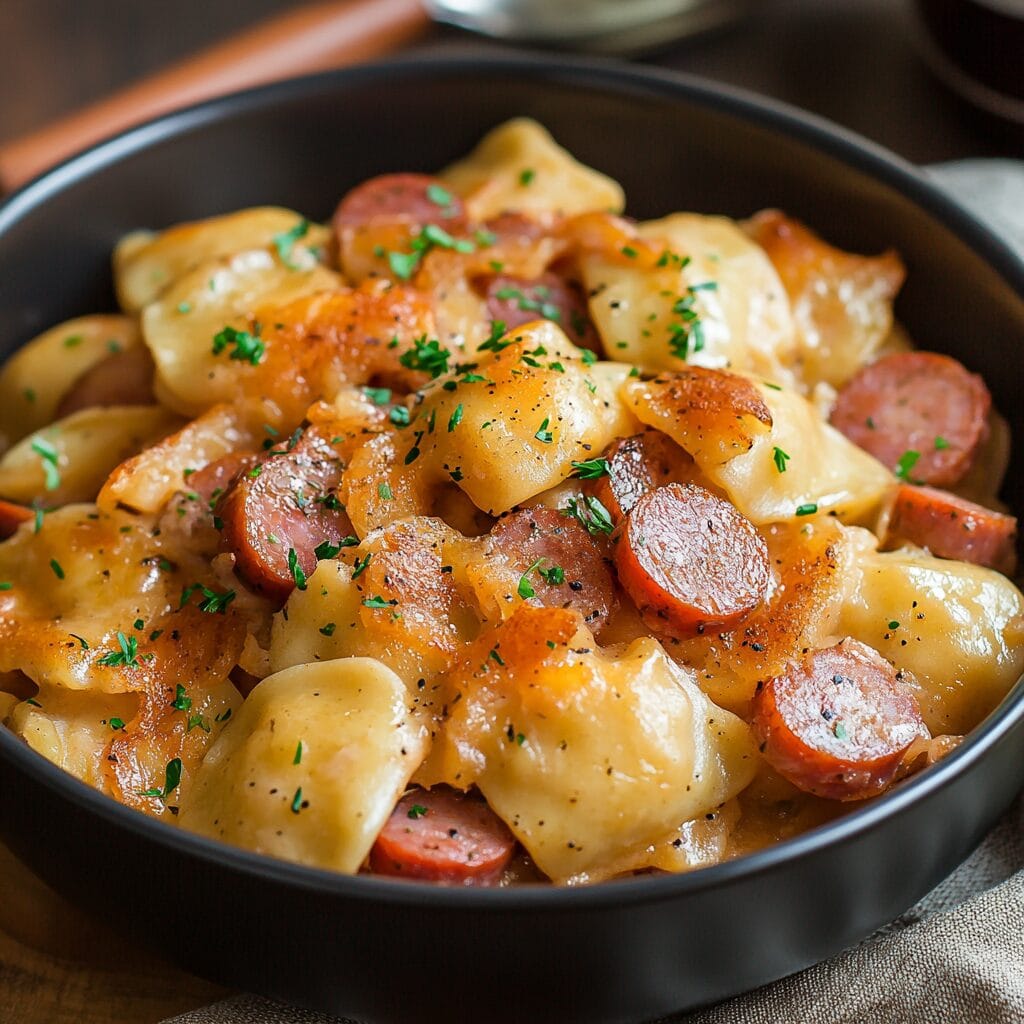
Flavor Profiles: Balancing Textures and Tastes
When you pair pierogies with kielbasa, you’re in for a treat. The soft, doughy exterior of pierogies, filled with creamy potatoes or tangy sauerkraut, contrasts beautifully with the firm, smoky bite of kielbasa. This combination offers a delightful balance of textures and flavors that dance on your palate.
“The creamy filling of pierogies paired with the smoky snap of kielbasa creates a harmony of flavors that’s simply irresistible.”
Cultural Significance of the Combination
In Polish culture, serving pierogies alongside kielbasa is more than just a meal it’s a tradition. This pairing often graces tables during festive occasions and family gatherings, symbolizing warmth, hospitality, and the rich tapestry of Polish culinary heritage.
“Serving pierogies and kielbasa together is like bringing a piece of Poland’s heart and soul to the table.”
Popular Ways to Cook Pierogies and Kielbasa Together
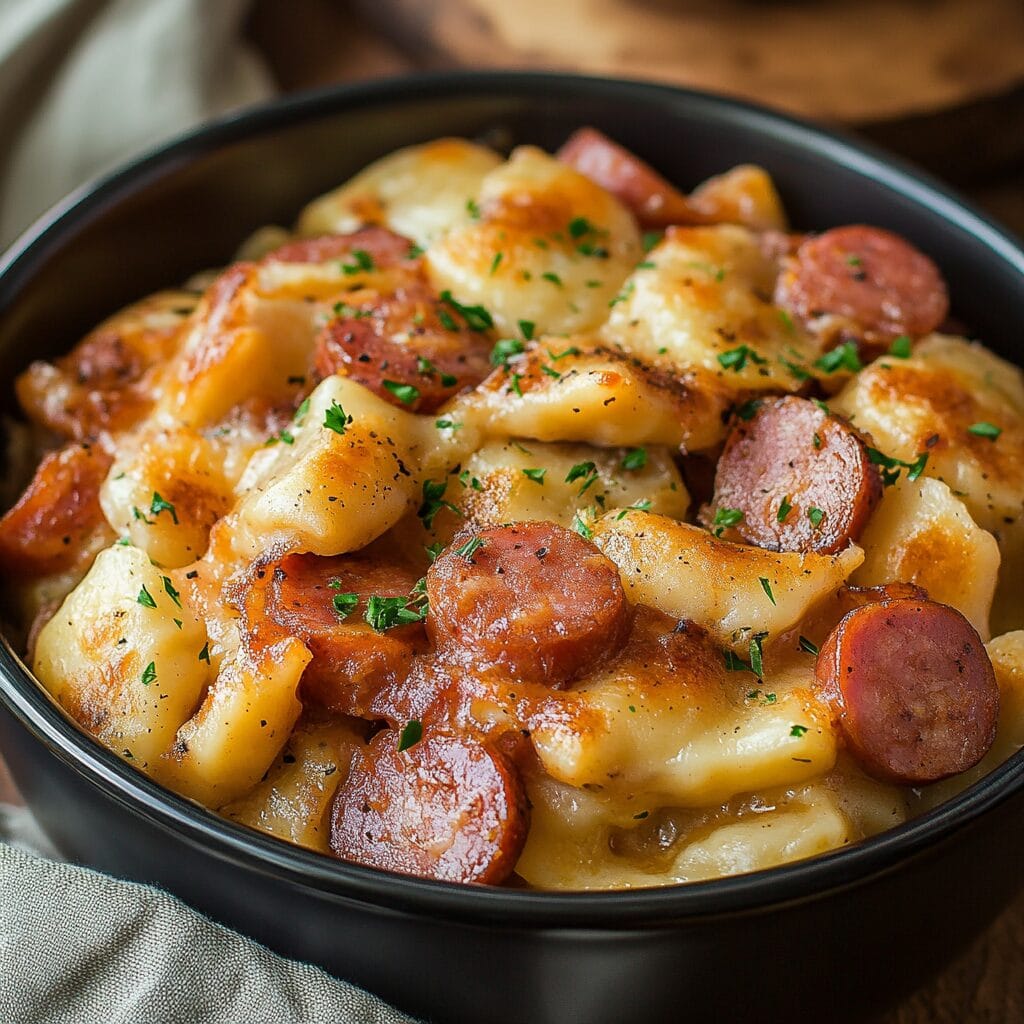
Skillet Sauté: A Quick and Flavorful Approach
A skillet sauté is your go-to option when you’re pressed for time but still want a satisfying meal. All you need is one pan, a few ingredients, and about 20 minutes. This method brings out the rich, smoky flavor of the kielbasa and gives the pierogies a crispy, golden edge.
Start by slicing the kielbasa into rounds and browning them in a little oil. Once they’ve got a nice sear, remove them from the pan and toss in some boiled or thawed pierogies. Let the pierogies cook until golden and slightly crisp on each side. Then, return the kielbasa to the skillet, toss everything together, and finish with sautéed onions or garlic if you like.
“This is my go-to weeknight dinner. Quick, simple, and packed with flavor!”
Here’s a quick table to help you prep this dish:
| Ingredient | Quantity |
|---|---|
| Pierogies (frozen or homemade) | 12 pieces |
| Kielbasa (sliced) | 12 oz |
| Olive oil | 2 tbsp |
| Onion (optional) | 1, thinly sliced |
| Garlic (optional) | 2 cloves, minced |
Sheet Pan Dinners: Convenience Meets Taste
If you love hands-off cooking, sheet pan dinners are the way to go. Just spread everything out on one tray, bake, and relax while dinner cooks itself. The oven crisps up the pierogies and caramelizes the kielbasa, locking in all that juicy flavor.
Here’s how to do it: Place frozen pierogies and sliced kielbasa on a baking sheet. Add bell peppers, onions, or cherry tomatoes if you like veggies. Drizzle with olive oil and sprinkle with your favorite seasonings. Bake at 400°F for 25–30 minutes, flipping halfway through for even browning.
This method is perfect for families or when you’re feeding a crowd. Plus, cleanup is super easy!
If you’re looking for more comforting meals like this, check out our recipe article on Sizzling Ultimate Cheesesteak Sandwiches for another crowd-pleasing dish.
What to Serve with Pierogies and Kielbasa
Traditional Sides: Sauerkraut and Sour Cream
Maintaining a classic approach is always effective when serving pierogies and kielbasa. Sauerkraut is a top pick,it’s tangy, crunchy, and pairs beautifully with the richness of the dumplings and sausage. Simply heat it up with a touch of butter and caraway seeds for extra flavor.
Another must-have is sour cream. Cool, creamy, and slightly tangy, it adds the perfect contrast to the hot and crispy pierogies. Some folks like to stir in chopped chives or dill for a fresh twist.
“Pierogies, kielbasa, sauerkraut, and sour cream,it’s the full Polish experience on a plate.”
Modern Twists: Fresh Salads and Roasted Vegetables
If you’re looking to lighten things up, pair your pierogies and kielbasa with a crisp green salad or a tray of roasted veggies. Think baby spinach tossed with a lemon vinaigrette or roasted carrots, zucchini, and red onions. These sides add freshness and color, turning a heavy dish into a balanced meal.
You could even go for a tangy cucumber salad with a vinegar dressing,it’s light, refreshing, and super easy to whip up.
Here’s a simple side salad idea:
| Salad Ingredients | Quantity |
|---|---|
| Baby spinach | 4 cups |
| Cherry tomatoes | 1 cup, halved |
| Cucumber | 1, sliced |
| Olive oil | 2 tbsp |
| Lemon juice | 1 tbsp |
| Salt & pepper | To taste |
Try serving these sides with your next pierogies and kielbasa meal,you’ll love how they brighten up the plate!
Understanding the Nutritional Content
Caloric Breakdown of Pierogies and Kielbasa
Let’s be honest,pierogies and kielbasa aren’t exactly what you’d call “light fare.” But that doesn’t mean they can’t be part of a balanced meal. Knowing what’s in your food helps you enjoy it wisely and guilt-free.
Here’s a simple table to give you a general idea of the nutrition per serving:
| Item | Calories | Protein | Fat | Carbs |
|---|---|---|---|---|
| 3 Potato & cheese pierogies | 210 | 6g | 7g | 30g |
| 4 oz kielbasa (smoked) | 330 | 14g | 28g | 2g |
Note: These are averages and may vary depending on the brand or homemade recipe.
So yes, pierogies and kielbasa can be high in calories and fat, especially when fried or served with creamy sides. But they’re also satisfying and comforting, which makes them worth enjoying once in a while.
Tips for a Balanced Meal
To keep things healthier, here are a few simple tips:
-
Choose lean kielbasa: Look for turkey or low-fat versions.
-
Boil or bake instead of frying: This cuts down on oil and keeps things lighter.
-
Add veggies: Roasted or steamed vegetables add fiber and balance the richness.
-
Watch the extras: Go easy on sour cream or opt for Greek yogurt as a topping.
When paired with the right sides and cooked in a mindful way, pierogies and kielbasa can definitely fit into a well-rounded meal.
Exploring Different Takes on the Classic Duo
Vegetarian Alternatives to Kielbasa
If you don’t eat meat, don’t worry,you can still enjoy the magic of this dish! Today, there are plenty of vegetarian kielbasa options available at most grocery stores. These plant-based sausages are made with ingredients like soy, peas, and even mushrooms. Often, they are pre-seasoned with smoky and garlicky flavors, mimicking the authentic taste.
Pair them with your favorite pierogies,especially ones filled with potato, cheese, or spinach,and you’ve got a meat-free version that’s still full of flavor.
“I switched to veggie kielbasa last year, and honestly, with crispy pierogies on the side, I don’t miss the meat at all!”
Gluten-Free Pierogi Options
Got gluten issues? No problem! You can now find gluten-free pierogies made with rice flour, almond flour, or other non-wheat blends. Many of them taste just as good as the classic versions. Or, if you’re feeling adventurous, try making your own dough at home using a gluten-free flour mix.
Just be sure to double-check the label when buying both pierogies and kielbasa, as some processed sausages may also contain gluten-based fillers.
For more delicious recipes and tips, check out our full guide on How to Make Taco Bell Nacho Cheese Sauce
Up next, we’ll look at how to buy and store these tasty ingredients so you always have them ready for your next cozy meal. Keep reading!
Where and How to Buy Pierogies and Kielbasa
Selecting Quality Products at the Store
Finding good-quality pierogies and kielbasa is easier than you might think. You can check the freezer section at your local grocery store for frozen pierogies. Look for well-known brands or ones that list natural ingredients like potatoes, cheese, and flour,nothing too fancy, just the basics.
For kielbasa, head to the deli or meat section. Smoked kielbasa is usually fully cooked and ready to eat after heating. Make sure to read the label for ingredients and check for too much added sugar or preservatives. If possible, try to buy from a Polish deli or European market for a more authentic flavor.
Tip: If you’re shopping for special diets, look for labels like “gluten-free,” “low sodium,” or “plant-based” right on the package.
Storage and Shelf Life Recommendations
Once you’ve bought your pierogies and kielbasa, you’ll want to store them right to keep them fresh. Frozen pierogies can last up to 3 months in the freezer,just make sure they’re sealed tight. Homemade ones? Freeze them right after shaping.
For kielbasa, if it’s vacuum-sealed and unopened, it’ll last a couple of weeks in the fridge. After opening, try to eat it within 5–7 days. You can also freeze kielbasa for longer storage,just wrap it well in foil or place it in an airtight container.
“I always keep a bag of pierogies and a pack of kielbasa in the freezer. It’s my emergency dinner plan!”
Enhancing Your Pierogies and Kielbasa Dishes
Achieving the Perfect Sear on Kielbasa
Want that crispy, golden crust on your kielbasa? The trick is to cook it low and slow in a skillet. Start by slicing your kielbasa into rounds or halves. Add a little oil to your pan and heat it over medium heat. Then place the sausage flat-side down and cook without touching it for 3–4 minutes. Flip it once it’s brown and repeat on the other side.
You’ll get crispy edges and juicy insides every time. Don’t rush the process,patience pays off.
“When I hear that sizzle, I know something delicious is on the way.”
Preventing Pierogies from Sticking or Breaking
There’s nothing worse than spending time on dinner and having your pierogies break apart in the pot. But don’t worry,there are easy ways to stop that from happening.
First, if you’re boiling frozen pierogies, make sure the water is boiling gently,not too hard. Stir them once right after you drop them in so they don’t stick to the bottom. When they float to the top, let them cook for 1–2 more minutes, then remove them gently with a slotted spoon.
If you’re pan-frying, use a nonstick pan or enough oil. Let the pierogies crisp up before flipping them. That way, they won’t tear or fall apart.
“Golden, crispy pierogies are worth the extra care. Just flip once and let the pan do the magic.”
Conclusion
So there you have it,everything you need to know about pierogies and kielbasa. This flavorful duo, with their rich history and tips for cooking, shopping, and serving, has endured for a reason. Whether you’re boiling, frying, baking, or tossing them on a sheet pan, this dish brings joy and comfort in every bite.
Don’t be afraid to make it your own. Try new fillings, explore meat-free versions, or serve it with a fresh salad for a modern twist. However you prepare it, pierogies and kielbasa are a warm and hearty way to feed both body and soul.
Feeling inspired? Head to the kitchen and give this classic combo a try,you might just find your new favorite comfort food.

